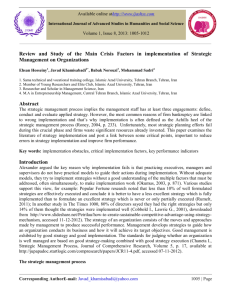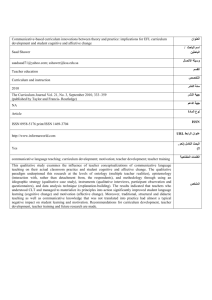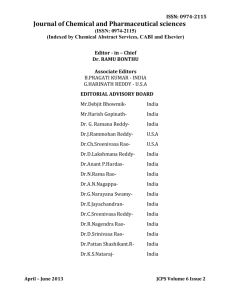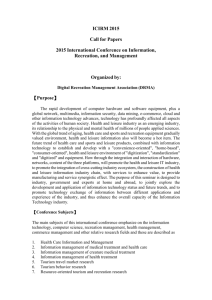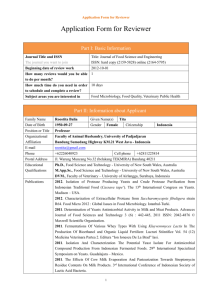The biggest failures in managing strategy implementation
advertisement
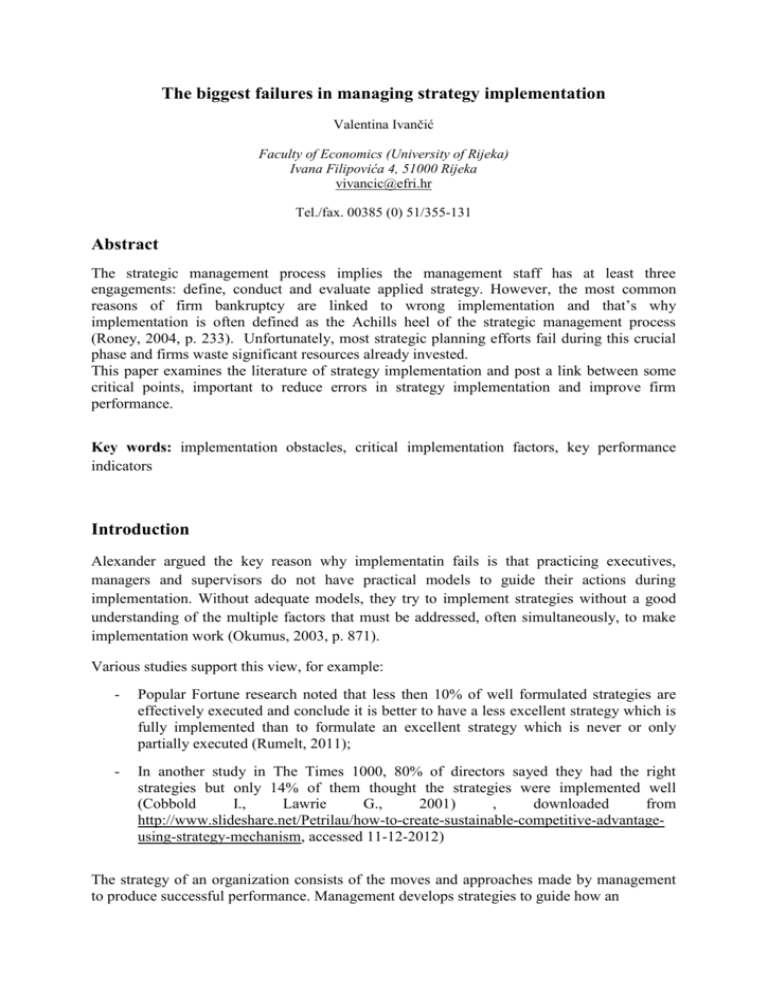
The biggest failures in managing strategy implementation Valentina Ivančić Faculty of Economics (University of Rijeka) Ivana Filipovića 4, 51000 Rijeka vivancic@efri.hr Tel./fax. 00385 (0) 51/355-131 Abstract The strategic management process implies the management staff has at least three engagements: define, conduct and evaluate applied strategy. However, the most common reasons of firm bankruptcy are linked to wrong implementation and that’s why implementation is often defined as the Achills heel of the strategic management process (Roney, 2004, p. 233). Unfortunately, most strategic planning efforts fail during this crucial phase and firms waste significant resources already invested. This paper examines the literature of strategy implementation and post a link between some critical points, important to reduce errors in strategy implementation and improve firm performance. Key words: implementation obstacles, critical implementation factors, key performance indicators Introduction Alexander argued the key reason why implementatin fails is that practicing executives, managers and supervisors do not have practical models to guide their actions during implementation. Without adequate models, they try to implement strategies without a good understanding of the multiple factors that must be addressed, often simultaneously, to make implementation work (Okumus, 2003, p. 871). Various studies support this view, for example: - Popular Fortune research noted that less then 10% of well formulated strategies are effectively executed and conclude it is better to have a less excellent strategy which is fully implemented than to formulate an excellent strategy which is never or only partially executed (Rumelt, 2011); - In another study in The Times 1000, 80% of directors sayed they had the right strategies but only 14% of them thought the strategies were implemented well (Cobbold I., Lawrie G., 2001) , downloaded from http://www.slideshare.net/Petrilau/how-to-create-sustainable-competitive-advantageusing-strategy-mechanism, accessed 11-12-2012) The strategy of an organization consists of the moves and approaches made by management to produce successful performance. Management develops strategies to guide how an organization conducts its business and how it will achieve its target objectives. Good management is exhibited by good strategy and good implementation. The standards for judging whether an organization is well managed are based on good strategy-making combined with good strategy execution (Chaneta I., Strategic Management Process, Journal of Comprehensive Research, Volume 5, p. 17, available at http://jupapadoc.startlogic.com/compresearch/papers/JCR11-4.pdf, accessed 07-11-2012) The strategic management process To be able to identify difficulties in the implementation phase it is important to understand the entire process of strategic management. According to Wheelen and Hunger (2002), firm strategy passes four stages: environmental scanning, strategy formulation, strategy implementation and strategy evaluation. Investigating why even the best designed strategies are questionable opens a doubt about inconsistencies between formulation and implementation at first and later inconsistencies between strategy implementation and performance measurement. Formulation phase includes mission, goals and business policy determination while implementation includes activities, budgeting and procedures. Figure 1. Components of Strategic Management Process Components of Strategic Management Process Source: adapted according to Wheelen T.L., Hunger D., 2002 Between these phases emerge several confusions: who carry out the strategic plan, what must be done and how to work. Strategy Implementation obstacles Unfortunately, most managers know more about developing strategy than they know about executing it. Formulating strategy is difficult. Making strategy work, executing or implementing throughout the organization, is even more difficult. Without effective implementation, no business strategy can succed (Hrebiniak, 2006, p. 12). The strategy implementation function consists in seeing what it will take to make the strategy work and to reach the targeted performance. It should be noted that in the strategic manangement literature there are more contributions on strategy making than strategy execution. In this chapter it will be discussed which are the potential implementation obstacles. Authors often in their research repeated factors or call them with different names but intend very similar thing. For example, Alexander L. (1985) mentioned 15 problems, Miller S. (1997) mentioned 10 critical factors, Al-Ghamdi S. (1998) 10 problems, Beer M. & Eisenstat R.A. (2000) identified six killers of strategy implementation, Kalali N.S., et al. (2011) mentioned 16 factors in four categories, while other authors have suggested more general categories. For example, some authors mention organizational structure as a critical factor while others mention communication, coordination, motivational and reward system separately. It is necessary to mention two extensive studies about the problems in the implementation strategy: - Noble C.H. (1999): The Eclectic Roots of Strategy Implementation Research. Noble as a conclusion of the literature review says this field is too little explored and that’s why is required a deeper reflection on the meaning of critical factors and certain aspects to define a useful implementation framework for practitioners. To start, he suggests there are two general dimensions in strategy implementation: the structural view (firm structure and control mechanisms) and the interpersonal process view (strategic consensus, behaviours, organizational climate, communication and interaction processes). In another article: Building the strategy implementation network, the same author suggests several managerial levers (goals, organizational structure, leadership, communications and incentives) essential in carrying out the implementation across the next implementation stages: preimplementation, organazing the implementation efforts, managing the implementation process and maximizing cross-functional performance. - Research in the article Making strategy work- A literature review on the factors influencing the implementation strategy wrote by Y. Li, Guohui S., Eppler MJ (2008) yielded the following conclusions. Individual factors that influence strategy implementation are divided into: soft factors (people oriented factors: communications, consensus and commitment), hard factors (institutional factors: organizational structure and administrative system) and mixed factors (strategy formulation, SBU relationship among different hierarchical levels and strategy etc.). Spontaneously, emerges the first hypothesis. H1. The identification of implementation failures allows to set up a list of critical factors in managing strategy implementation. The following table chronologically shows which problems arise from different surveys on strategy implementation from 1980s to nowadays. Table 1. Highlighted problems in strategy implementation Authors and work (chronological order) Waterman RH, Peters TJ, Phillips JR (1980): Structure Is not organization Wernham R (1984): Bridging the Awful Gap between Strategy and Action Alexander L. (1985): Successfully implementing strategic decision Eisenstat R. (1993): Implementing strategy: ddeveloping a partnership for change Wessel J. (1993): The strategic human resource management processin practice Schmidt J. (1994): The case of the sales-driven company Sandelands E. (1994): All talk and no action? Perish the thought Miller S (1997): Implementing Strategic Decisions: Four key Success Factors Al-Ghamdi, S. (1998): Obstacles to successful implementation of strategic decisions Beer, M., Eisenstat R.A. (2000): The silent killers of strategy implementation and learning Allio M.K. (2005): A short, practical guide to impleementing strategy Hrebiniak L.G. (2006): Obstacles to effective strategy implementation Kalali, N.S., et al. (2011): Why does strategic plans implementation fail? A study in the health service sector of Iran Time ● Organization structure ● ● ● ● ● ● Organization culture ● ● ● ● Resources Leadership ● ● ● ● ● ● ● ● ● Uncontrollable external factors ● ● ● ● ● ● ● ● ● ● ● ● ● ● ● ● ● ● Source: author own work All of these factors suggest an inconsistency between planning and implementation. Probably, in the planning phase these factors were not sufficiently explored and clarified. It is necessary to study each category separately in order to set up an adequate roadmap of targets for strategy executors. More frequently mentioned problems are related to organizational structure, the lack of resources and leadership problems. The first five categories mentioned in the table above refers to internal factors, while the sixth category ilustrate the impact of external factors. The following table shows how factors are sorted and grouped in each category. Besides these factors, some of the mentioned authors (Alexander, Wessel, AlGhamdi, Kalali and Allio) noted the impact of an additional factor which they called “distractors” indicating a deviation from the original plan objectives. Referring to this category, usually, are mentioned short term competing activities that distracted attention from planned implementation targets. Table 2. The most mentioned aspects of each critical implementation factor Critical factors Time Aspects - Took more time than originally allocated - Took more time than the formulation phase Organization structure Organization culture Resources Leadership Uncontrollable external factors Source: author own work - Inconsistencies in traslating long range plans into short term objectives (changes not introduced in daily routines) Means improper organizational design which includes: lack in communication, coordination, monitoring and incentive systems. Improper coordination: - Activities and tasks not sufficiently defined (inneficient operation planning) - Poor coordination across functions or divisions - Inadequate alignment between process' phases Improper communication: - Poor vertical and horizontal communication (between different hierarchical levels and functions) - Poor information and knowledge transfer (MIS) Improper monitoring and incentive system: - Poor responsabilities determination - Enefficient incentive programs - Lack in measuring performance - Poor implemented beliefs and values system - Conflicting strategy principles - Inability to overcome resistence to change This category includes tangible and intangible resources. But most authors relate to human resources: Quantitative indicators: - Too few people involved in implementation Qualitative indicators: - Inadequate employee skills and capabilities - Inadeguate training and instructions - Goals and target not well understood - Responsabilities not clearly defined - Lack of employee commitment - Not exist or inadequate measures of employee engagement - Not exist or inadequate reward system On physical resources referred only Alexander, Wernham and Miller (research from the '80s-90s probably influenced by the RBV theory). Authors refer to the knowledge and leadership skills. The most mentioned problems are: - Vague strategy formulation - Leaders consider their job is done when they finished with the planning - Left the organization during the implementation - Implementation tasks and activities not defined enought detailed - Top and middle management conflicting goals and priorities- middle management tasks modification - Inadequate leadership style: top down or laissez fair senior management, not collaborative management Alexander, AlGhamdi and Kalali in their studies emphasize the impact of external factors on business operations. Firms should adapt to the environment and with its strenghts take what is good and avoid what is negative. The most mentioned factors belongs to: political, economic, social and technological environment Still important to note that internal factors have a direct impact on strategy implementation while the impact of environmental factors usually have a moderating or mediating effect on strategy performance which implies the following hypothesis: H2. A comprehensive view of the impact of critical implementation factors on firm performance must be examined from two aspects: endogenous (internal) and exogenous (external) Strategy-making and strategy-implementation do not guarantee superior organizational performance continuously. Even well managed organization can sometimes hit the skills for short periods because of adverse conditions beyond management’s ability to foresee and react to the environment changes. It is management’s responsibility to adjust negative conditions by undertaking strategic defenses and managerial approaches that can overcome adversity. However, the essence of good strategy-making is to build a strong and flexible position to provide successful performance despite the impact of unforeseeable and unexpected external factors. The task of strategizing is always an ongoing exercise. “The whats” of an organization's mission and long-term objectives, once chosen, may remain unaltered for several years. But the “hows” of strategy evolve constantly, partly in response to an everchanging. Strategic management process depend partly from the managers’ efforts to create new opportunities, and partly from fresh ideas about how to make the strategy work better (Chaneta I., Strategic Management Process, Journal of Comprehensive Research, Volume 5, p. 18-19). The impact of critical implementation factors on the firm performance Strategy evaluation is the final step of strategy management process. The key strategy evaluation activities are: appraising internal and external factors that are the root of present strategies, measuring performance, and corrective actions when necessary. Evaluation makes sure that the organizational strategy as well as it’s implementation meets the organizational objectives. Any successful evaluation begins with defining the parameters that must be measured. These parameters should match the goals set in the strategy formulation and the activities in the execution phase. Many researchers discussed about the metrics coherent with strategy formulation and implementation principles. One of the most mentioned concept is the balanced scorecard proposed by Kaplan and Norton in the 1990s. Every firm adopts a specific set of key performace indicators. These indicators measure whether driving activities led to the expected results. Perfomance indicators must follow critical implementation factors what include: 1. measuring necessary time for strategy execution, 2. organizational structure adequacy, 3. organizational culture adequacy, 4. resource planning and 5. leadership. For external factors, it is important to set up a detailed assessment of their occurrence and impact. It is also important to apply quantitative and qualitative indicators. Detailed studies of critical factors will result in a series of indicators important to monitor the improvement of related activities, crucial for successful implementation. To develop an implementation framework, I propose the last two hypotheses. H3. Critical implementation factors allow to define a hypothetical framework for effective and efficient strategy implementation; H4. A hypothetical framework for strategy implementation is important to fix who, what, where and when undertake activities related to implementation. The following model summarizes critical implementation factors important to propose a framework for efficient strategy implementation. Without guidelines, execution becomes a labyrinth. Without guidance, individuals do the things they think are important, often resulting in uncoordinated and divergent outcomes. Without the benefit of a logical approach, execution suffers or fails because managers don’t know what steps to take and when to take them. Figure 1. Basic framework for strategy implementation Environment uncontrollable factors Leadership Resources Organizational structure Time Organizational culture Framework for efficient strategy implementation must contain: Detailed guidelines for: Metrics Evaluation of: Organizational structure Quantitative KPI External opportunities Organizational culture Qualitative KPI External threats Resources Leadership Time Source: author own work Having a roadmap positively affects execution success, but not having it leads to execution failure and frustration. Conclusion Strategic management process is a very complex and long term process which requires to define, conduct and evaluate applied strategy. The article started with the identification of implementation critical factors and ended with an implementation framework all strategy executors must understand and be able to apply in own work in order to reduce unexpected and unexplained effects. Critical factors can be grouped into several categories, and it is necessary to analyze the specificity of each category in order to determine whether the error refers to the planning stage or the implementation phase and if there are installed correct monitoring mechanisms. So, next studies should elaborate what is essential in each category and how to measure that. Besides quantitative data, for deep analysis, it is important to include qualitative data, too. It is possible to conclude the implementation phase predicts to analyze the following key factors: leadership, organizational structure, organizational culture, resources, time and the impact of environmental variables. Literature Books Roney, C.W. (2004). Strategic Management Methodology, Praeger Publishers, ISBN 156720-629-8, Westport. Wheelen, Thomas L.; Hunger, J. David (2006). Strategic Management and Business Policy: Toward Global Sustainability, ISBN 10: 013215322X. Articles in journals Alexander L. (1985): Successfully implementing strategic decision, Long Range Planning, 91-97, ISSN 00246301. Al-Ghamdi, S. (1998). Obstacles to successful implementation of strategic decisions: The British experience”, European Business Review, 322-327, ISSN 0955-534X. Beer, M., Eisenstat R.A., (2000). The silent killers of strategy implementation and learning, Sloan Management Riview, 29-40, ISSN 1532-9194. Allio M.K. (2005): A short, practical guideto impleementing strategy, Journal of Business Strategy, 12-21, ISSN 0275-6668. Chaneta I., et al. Strategic Management Process, Journal of Comprehensive Research, available at http://jupapadoc.startlogic.com/compresearch/papers/JCR11-4.pdf, accessed 0711-2012) (Cobbold I., Lawrie G., 2001, downloaded from http://www.slideshare.net/Petrilau/how-tocreate-sustainable-competitive-advantage-using-strategy-mechanism, accessed 11-12-2012) Hrebiniak L.G., (2006). Obstacles to Effective Strategy Implementation, Organizational Dynamics, 12–31, ISSN 0090-2616. Kalali, N.S., et al. (2011). Why does strategic plans implementation fail? A study in the health service sector of Iran, African Journal of Business Management, 9831-9837, ISSN 19938233. Noble C.H. (1999). The eclectic Roots of Strategy Implementation Research, Journal of Business Research 45, 119–134, ISSN ISSN 0148-2963. Noble C.H. (1999) Building the strategy implementation network, Business Horizons, 20-28, ISSN 0007-6813. Li Y., Guohui S., Eppler M.J. (2008). Making Strategy Work: A Literature Review on the Factors influencing Strategy Implementation, available at http://www.knowledgecommunication.org/pdf/making-strategy-work.pdf, (accessed 11-02-2013) Miller S (1997). Implementing Strategic Decisions: Four key Success Factors. Organ. Stud., 577-602, ISSN 0170-8406. Okumus, F. (2003). A framework to implement strategies in organizations, Management Decision, 871 – 882, ISSN 0025-1747. Sandelands E. (1994): All talk and no action? Perish the thought, Management Decision, ISSN 0025-1747. Schmidt J. (1994). The case of the sales-driven company, Journal of Business Strategy, 17-20, ISSN 0275-6668. Wessel J. (1993): The strategic human resource management processin practice, Planning Review, 37-38, ISSN 0251-3625. Wernham R (1984). Bridging the Awful Gap between Strategy and Action, Long Range Planning, 34-42, ISSN 00246301. Waterman RH, Peters TJ, Phillips JR (1980). Structure Is Not organization. Bus. Horiz.,1426, ISSN 1993-8233. Wheellen and Hunger (2002). Strategic management and business policy, Harvard Business School, Prentice Hall, available at http://hbsp.harvard.edu/he-main/resources/documents/webfiles/STRAT-Wheelen-Hunger.pdf, (accessed, 12-01-2013)



